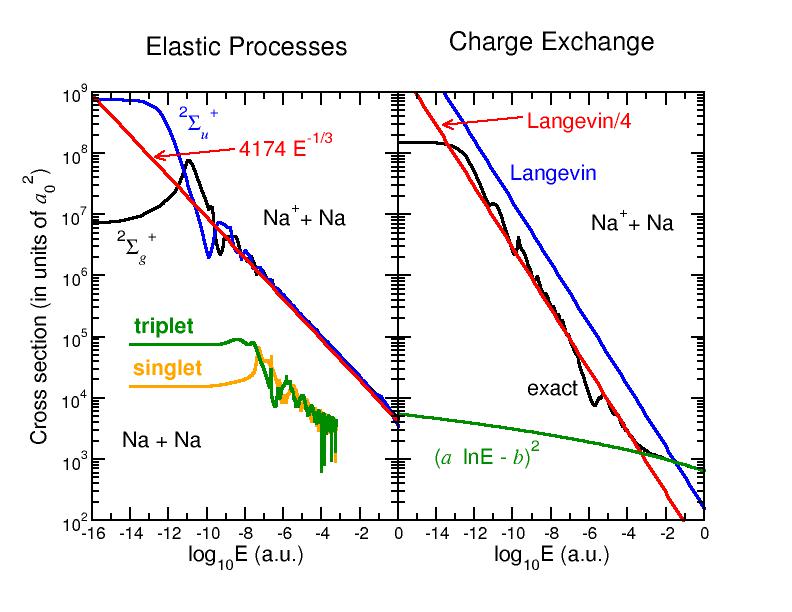 Scattering of charged particles has a long history. However, the interaction
of ions and neutral particles in the ultracold regime is a nascent
sub-field in AMO physics. In our early studies of Na colliding with
Na+, we found that the cross sections
of elastic and charge exchange processes are very large due to the
very long-range C
4/R4
polarization interaction potential between
an ion and neutral atom (for molecular
species, additional angular dependence may exist). In systems such as
Na+Na+, both the ion and its parent
approach each other along two potential curves (a gerade and ungerade
curve), and the scattering cross sections are given by
Scattering of charged particles has a long history. However, the interaction
of ions and neutral particles in the ultracold regime is a nascent
sub-field in AMO physics. In our early studies of Na colliding with
Na+, we found that the cross sections
of elastic and charge exchange processes are very large due to the
very long-range C
4/R4
polarization interaction potential between
an ion and neutral atom (for molecular
species, additional angular dependence may exist). In systems such as
Na+Na+, both the ion and its parent
approach each other along two potential curves (a gerade and ungerade
curve), and the scattering cross sections are given by
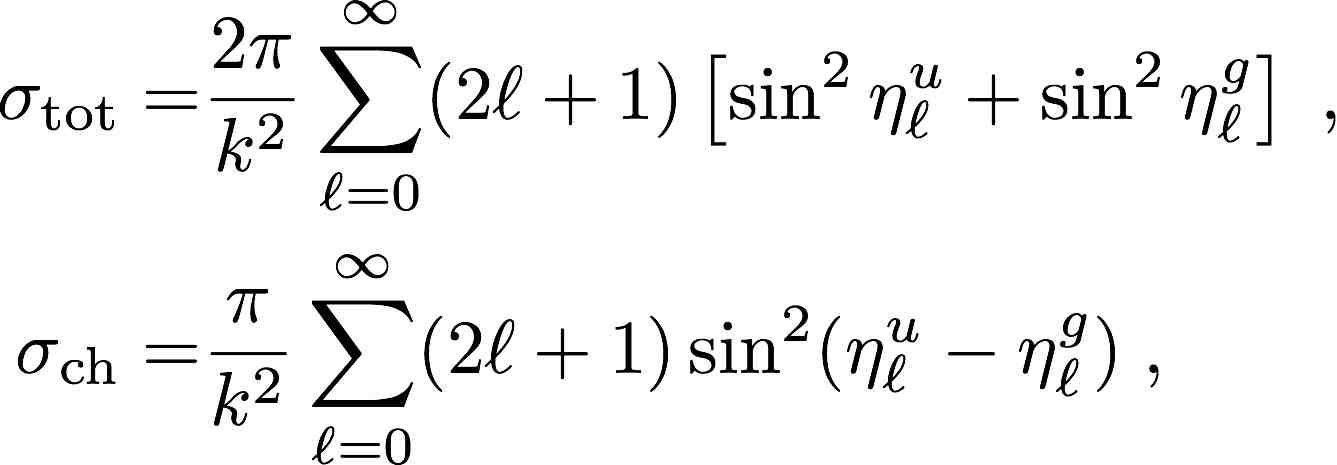 ,
, 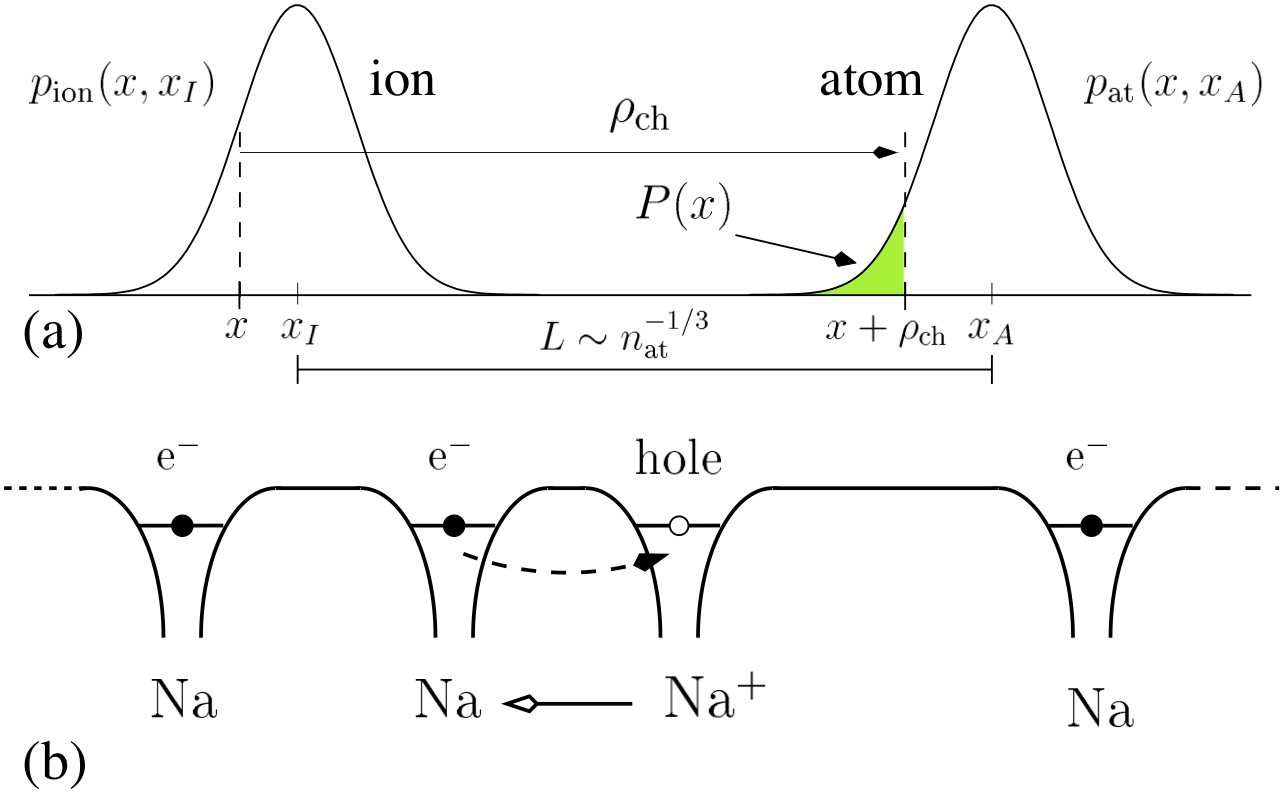
 ,
,
An interesting question arises: how does the charge diffuse when the
temperature T
becomes extremely low ? From the charge transfer
cross section
σc
h
=
πρch
2,
we can define a charge transfer length scale
ρch.
As E
∼ kB
T decreases,
σch
∼ T -1/2 leads to
ρch scaling as
T -1/4
while the de Broglie's wavelength of the ion/atom scales as T -1/2.
As we sketch in the figure (a) beside, as the temperature is lowered, the charge exchange
radius increases faster than the de Broglie wavelength (shown as the gaussian envelope),
so that there is a non-zero probability
P(x)
of having the atom-ion pair within the
charge exchange radius. By integrating over all possible location
x, we obtain the total probability of being within
the charge exchange radius. At that point, while the ion and
atom are basically immobile, charge exchange can take place
very efficiently by having the electron (or equivalently the
hole) hopping between atom and ion.
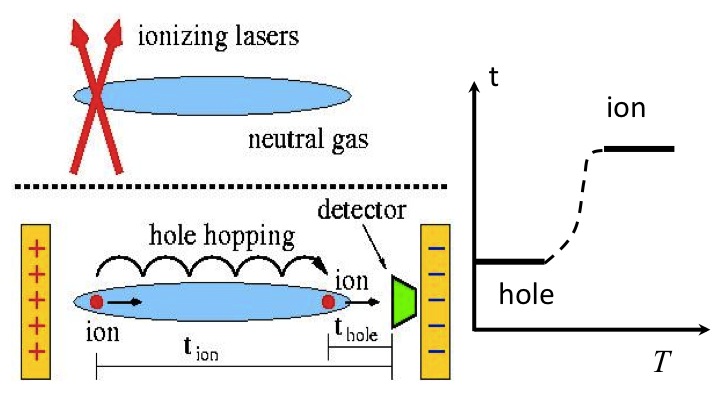 This hopping conductivity
should be very efficient and dominate the transport
properties at very low temperatures. We proposed a
simple experiment to detect such behavior. This is
sketched beside: after preparing an ion at a given
location in a cold sample (e.g. using two crossed
laser beams), a small electric field is applied and
the ion is detected. Depending on the temperature,
two time scales should occur: at higher temperature
where the charge is moving with the "heavy" ion, it
would take more time to accelerate the charge to the
detector, while at lower temperatures, the "light"
hole would hop easily from atom to atom before resting
on a last ion reaching the detector, leading to a
shorter time scale.
This hopping conductivity
should be very efficient and dominate the transport
properties at very low temperatures. We proposed a
simple experiment to detect such behavior. This is
sketched beside: after preparing an ion at a given
location in a cold sample (e.g. using two crossed
laser beams), a small electric field is applied and
the ion is detected. Depending on the temperature,
two time scales should occur: at higher temperature
where the charge is moving with the "heavy" ion, it
would take more time to accelerate the charge to the
detector, while at lower temperatures, the "light"
hole would hop easily from atom to atom before resting
on a last ion reaching the detector, leading to a
shorter time scale.
We also investigate other neutral-charged mixtures. For example, we are
interested in charge exchange processes when the ion and atom are isotopes
of the same element. In that case, because of the slight shift in energy levels
(arising mainly from the mass difference) the processes are not resonant,
and the charge transfer can be identified since different isotopes have slightly
transition frequencies/wavelengths. Alkaline-earth (group II) elements are
particularly interesting, since both the ion and the neutral atom can be
optically detected. We have been studying one of the simplest one: Be. We are
introducing other interactions, such as the hyperfine and Zeeman interactions;
as in the case of scattering in neutral samples, we expect to witness Feshbach
resonances strongly affecting the collision and transport properties in mixed
samples.
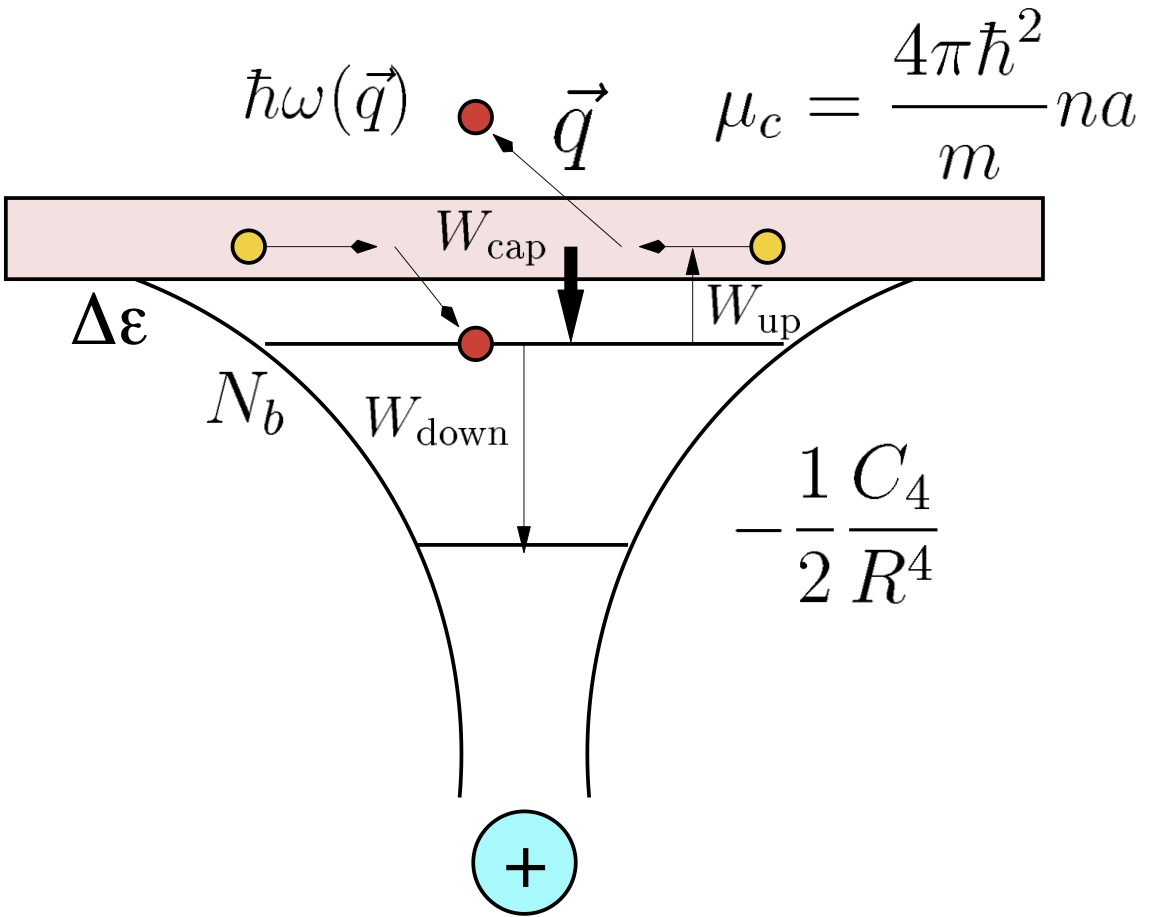 Another type of mixtures involving an ion in a cold sample of distinguishable
neutral atoms is being studied experimentally by several groups. We initiated
this effort using Ca+ ions immersed in an
ultracold sample of Na atoms. Because charge transfer occurs by a radiative
process for ground state collisions (i.e. a photon must be emitted to transfer
the system from Na+Ca+ to
Na++Ca), the rate is small (i.e. the process
not very fast), which allows cooling of Ca+
by elastic collisions with ultracold Na atoms. Several experimental groups
are exploring similar systems (e.g., Rb with Ba+
or Yb+ or Ca+).
One of the motivation is our prediction of the formation of large mesoscopic
molecular ions when an ion is immersed into a BEC. As shown in the figure
beside, the ion provides an attractive polarization potential, and when two
atoms (yellow discs) scatter in its presence, one can be captured into a bound
level with a rate Wcap, while the
other atom takes the extra momentum q (red discs). In a BEC, this
creates an excitation, or a quasi-particle (phonon) emission. We predicted
large capture rates, and the existence of large metastable mesoscopic
molecular ion "cluster" in steady-state (containing hundreds of atoms).
(see
Degenerate quantum gases, BEC and BCS for more details).
Another type of mixtures involving an ion in a cold sample of distinguishable
neutral atoms is being studied experimentally by several groups. We initiated
this effort using Ca+ ions immersed in an
ultracold sample of Na atoms. Because charge transfer occurs by a radiative
process for ground state collisions (i.e. a photon must be emitted to transfer
the system from Na+Ca+ to
Na++Ca), the rate is small (i.e. the process
not very fast), which allows cooling of Ca+
by elastic collisions with ultracold Na atoms. Several experimental groups
are exploring similar systems (e.g., Rb with Ba+
or Yb+ or Ca+).
One of the motivation is our prediction of the formation of large mesoscopic
molecular ions when an ion is immersed into a BEC. As shown in the figure
beside, the ion provides an attractive polarization potential, and when two
atoms (yellow discs) scatter in its presence, one can be captured into a bound
level with a rate Wcap, while the
other atom takes the extra momentum q (red discs). In a BEC, this
creates an excitation, or a quasi-particle (phonon) emission. We predicted
large capture rates, and the existence of large metastable mesoscopic
molecular ion "cluster" in steady-state (containing hundreds of atoms).
(see
Degenerate quantum gases, BEC and BCS for more details).